Yves here. The literature on cognitive biases has many examples of how presenting the same economic proposition in different terms, such as insurance versus a bet, will elicit different responses. Here we has the Russian gas cognitive bias. If it comes via a dedicated pipeline, as in no way, no how can Europeans kid themselves as to what they are buying, then it’s supporting Putin’s war machine and continuing to consume it would be sacrilegious. But LNG via tanker? Most Europeans seem to regard that as all a muchness.
Speaking of Putin, he was early to observe and make use of the Russian gas cognitive bias. He and Erdogan are confident that Russian pipeline gas, when it goes through a Turkish hub and will be presumed to have been mixed with gas from other countries, will be deemed to have lost its Russian character.
By John Helmer, the longest continuously serving foreign correspondent in Russia, and the only western journalist to direct his own bureau independent of single national or commercial ties. Helmer has also been a professor of political science, and an advisor to government heads in Greece, the United States, and Asia. He is the first and only member of a US presidential administration (Jimmy Carter) to establish himself in Russia. Originally published at Dances with Bears
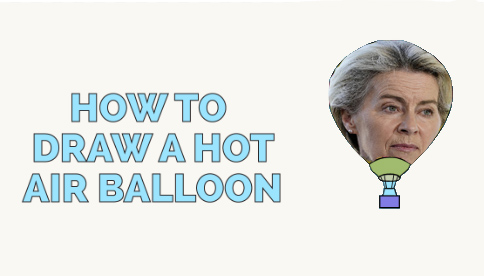
When Ursula von der Leyen (lead image) was nominated in 2019 to be Germany’s candidate to lead the European Commission, German politicians from her own party privately described her as too stupid and potentially too corrupt to be risked inside Germany during the political succession race to succeed Angela Merkel as Chancellor. German military sources say von der Leyen was the stupidest defence minister in German military memory.
Since the war began in February, von der Leyen did not say a true word until November 30, when she announced that Ukrainian military deaths had reached more than 100,000, and civilian fatalities more than 20,000. Within hours these numbers were removed from the published record of her speech. Von der Leyen’s admission implied the war toll of Ukrainian wounded is more than 300,000, and that the sum of military and civilian casualties has already reached half a million. Von der Leyen was confirming Russian estimates and contradicting the Kiev regime’s propaganda.
In September von der Leyen announced her support for a price cap on the international trade in exports of Russian pipeline gas and liquefied natural gas (LNG). Last month she said the European Union is “ready to go” with a price cap on Russian oil exports.
However, the European and Asian gas and oil trade is not only contradicting what von der Leyen is claiming; it is demonstrating they are profiting from her public lies. In the gas market there is new evidence that the French, Dutch and Belgian governments are allowing the purchase of record volumes of imported Russian LNG, and the re-export of this gas at a profit to other European states, including Germany. The arbitrage – that is, the profit from buying Russian LNG at the Russian selling price and then reselling it at a premium to European consumers – is so lucrative, the Chinese are diverting their contracted volumes of Russian LNG to Europe.
Olga Samofalova, the energy market analyst at Vzglyad , reported yesterday on how the markets are defeating the sanctions.
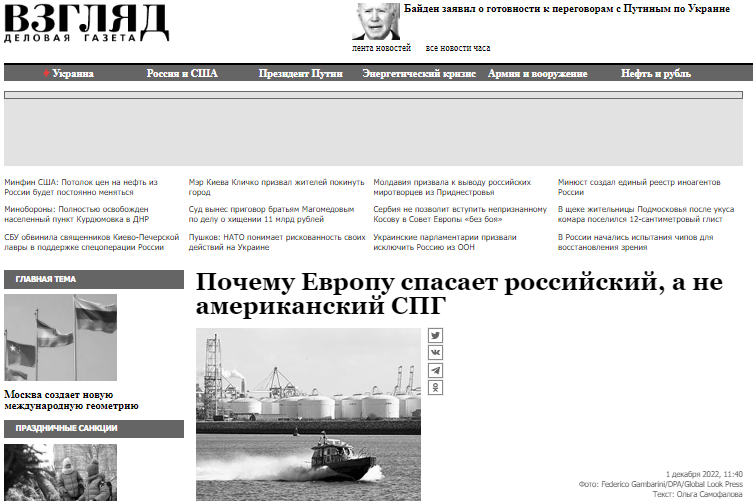
Source: https://vz.ru/
The translation which follows is verbatim, without editing. The illustrations and URL links have been added.

WHY EUROPE IS BEING SAVED BY RUSSIAN LNG, NOT AMERICAN LNG
December 1, 2022
Text: Olga Samofalova
While pipeline gas supplies from Russia are under scrutiny, the European Union (EU) is quietly buying up more and more volumes of the other Russian gas – that is, liquefied natural gas (LNG). Europe’s costs of importing Russian LNG have soared to record levels, Bloomberg has discovered. How did Russia start supplying more liquefied natural gas to Europe and, most importantly, why do the Europeans themselves see nothing terrible in this?
As you know, Brussels has imposed a Russian coal embargo; an oil embargo will start operating in a week. A number of countries have refused pipeline gas supplies; others have let technical and bureaucratic problems of the “Northern Streams” take their course. They claim not to have noticed the destruction of the Nordstream pipelines or the way in which the Ukraine has been so unaffected by the present situation that it has restored the transit volumes of gas across Ukrainian territory.
At the same time, Europe’s costs for importing Russian LNG in 2022 have soared to a record level, according to Bloomberg. The EU has increased the purchase of LNG from Russia by about 40% over this year. The EU spent a record €12.5 billion ($13 billion) on Russian LNG from January to September – five times more than a year earlier. This is a bitter pill for many countries of the bloc, which imposed tough sanctions on the Kremlin in order to deprive it of funds to conduct its military operations in Ukraine, the western news agency writes.

Source: https://www.bloomberg.com/

Source: https://www.bloomberg.com/
As ship and port tracking data show, growing demand from countries such as France and Belgium has helped make Russia the number-two LNG supplier to northwest Europe this year. In the first place is Qatar, which traditionally supplies LNG to the European region. The current situation is that northwestern Europe accepts significantly more Russian than American LNG, although it was the United States which promised to save the Europeans with its gas after the removal of Russian pipeline supplies.
It should be understood that Belgium, the Netherlands and France accept Russian LNG, but then it is distributed throughout Europe. Among European countries, only the UK and the Baltic states have stopped buying Russian LNG.
Russian LNG will continue to flow to Europe, and most European countries are happy to turn a blind eye to this, says Anne-Sophie Corbeau, a researcher at the Center for Global Energy Policy at Columbia University. Because the EU is faced with a real physical shortage of natural gas, this leads not only to the high cost of the resource, but also to a reduction in the work of industry, and therefore of their demand for fuel.
There are two LNG plants in the north-west of Russia. These are Gazprom’s Portovaya and Vysotsky LNG. However, these are small plants; the first of them started working only this autumn. Accordingly, we are mainly talking about the supply of Novatek’s Yamal LNG to Europe. Initially, the Yamal LNG plant was counting on delivering its supplies to Asia, primarily to China. And until 2022, the main volumes from Novatek did indeed go there.
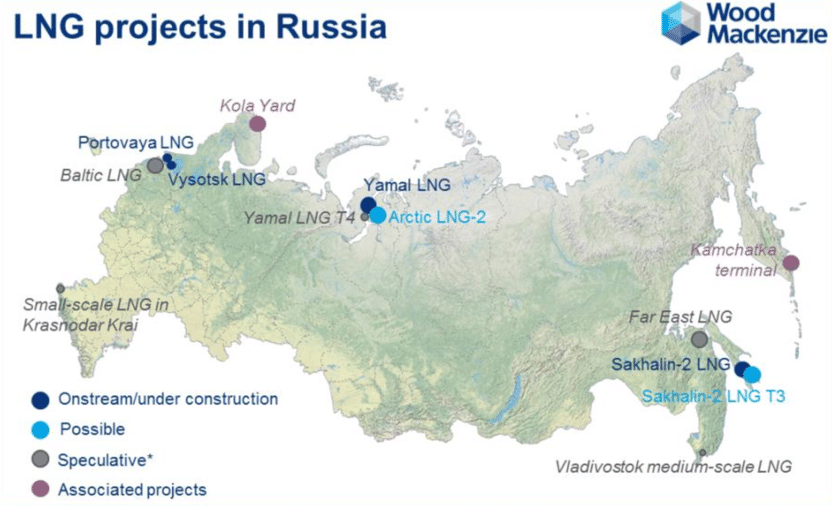
Why has the situation changed so much this year?
Firstly, for the first time, the European market, not the Asian one, has become the premium market for gas. Until 2022, gas prices in Europe were always lower than in Asia. Now everything is the other way around, so the growth in Russian LNG supplies is explained by the economic or commercial factor, says Igor Yushkov, a leading expert of the National Energy Security Fund, an expert at the Financial University under the Government of the Russian Federation.
The second point is that there are ice restrictions for the supply of Yamal LNG to Asia. “As soon as the navigation season on the Northern Sea Route ends, LNG can only be shipped to Europe. But when the premium market was Asian, often what happened in winter was that Yamal LNG was shipped to Europe by ice-class tanker, , then reloaded on a conventional tanker, and then this LNG cargo went through the Suez Canal to Asia,” explains Yushkov. But this year, all free LNG from the market is being vacuumed up, not by China, but by Europe.
“Therefore, even in the summer, when Novatek Yamal had the opportunity to supply LNG via the Northern Sea Route to the East, the main volumes still went to the European market for economic reasons,” Yushkov adds.
The third reason is the overall increase in the capacity of the Yamal LNG plant, where all four stages are operating at full capacity this year. The design capacity is about 16.5 million tonnes, but by the end of the year, much more will be produced – about 20 million tonnes.
It is noteworthy that almost 16 million tonnes are contracted and have been delivered under long-term contracts to the signing customers. But the gas which the plant produces in excess of these volumes is not under contract and this is going to the spot market. The owner of Yamal LNG, Leonid Mikhelson, has said that the company now earns more from these surpluses, which amount to about 4 million tonnes, than it earns from the contract sale of all the other 16 million tonnes.
This is easily explained. The contracts were signed when LNG prices were significantly lower than they are now. Buyers of Russian LNG under these contracts are in a very favourable position for themselves. But Novatek is already selling the “surplus” at spot prices – and they are many times more expensive.

Source: https://www.bloomberg.com/
“Even the Chinese company CNPC, which has a contract with Novatek, sells part of this LNG on the European market, acting as a trader,” says Yushkov. We are talking about the fact that it is profitable for a Chinese company to resell LNG to Europeans and get a favourable margin on the difference between the purchase price (which is prescribed in the contract) and the spot price at which Europeans buy.
Gas consumption in China has decreased, firstly, due to the ongoing lockdowns this year. Secondly, because of the increase in coal consumption against the background of the withdrawal of the European environmental agenda into the shadows. China has increased its own coal production and increased coal imports from Russia at attractive prices.
Thus, the growth of Russian LNG supplies to Europe is explained by economic factors. And that’s why the EU is quietly increasing its purchase and does not consider this a problem, whereas there is a constant chatter in European political circles about pipeline gas from Russia and the necessity of getting rid of it.
According to Bloomberg, the share of Russian pipeline gas in the region has decreased from 30% in 2021 to 10% in 2022. By contrast, the share of LNG in Russian supplies to Europe is now close to half.
“Europeans do not perceive LNG as a kind of national gas. They do not have the same negative attitude towards LNG as they have towards pipeline gas. Perhaps this is all because of the demonization of Gazprom, which has been obvious for more than a year now. This is because pipeline gas has always come from Russia and from Gazprom until now,” says Yushkov. Whereas LNG was initially perceived as the gas which would rescue everybody from Russian gas. First of all, the United States actively advertised its LNG as the salvation for Europe. In other words, the European perception is all about effective PR and the right headlines in the media, which help to form the public and political distinction between “good gas” and “bad gas”.
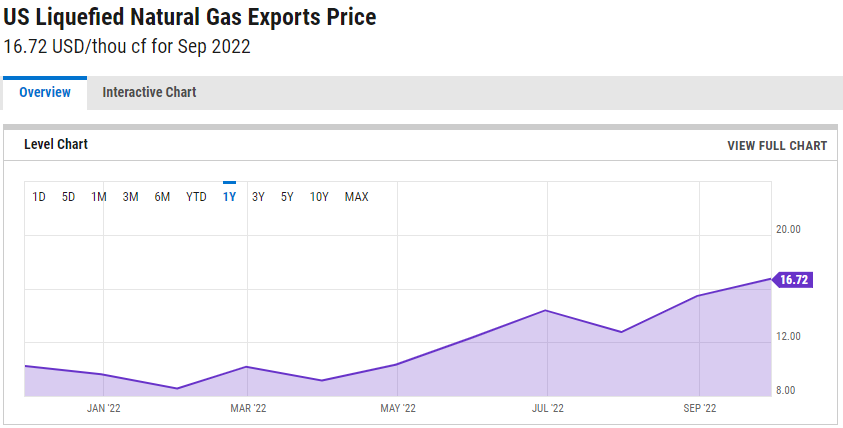
Source: https://ycharts.com/
Bloomberg has been reporting the surge in Chinese “discount” buying of Russian LNG.
At the same time, Yushkov notes that, in principle, the Europeans have not refused Russian gas, with the exception of several countries. This is despite the fact that European politicians have talked about reducing the Russian gas share and in a few years’ time abandoning it altogether. However, problems have arisen with the failure to deliver this gas through the pipelines. The reasons for that, as you know, are well known and quite different.
The Yamal–Europe gas pipeline was closed by the Poles due to the nationalization of Gazprom’s share in the pipe operator. Ukraine refused to accept gas through the Sokhranovka pumping station, so only Sudzha has remained.
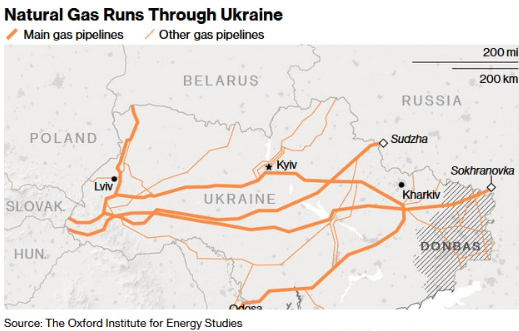
According to the contract, 109 million cubic meters per day should go through Ukraine, and for now the flow is two and a half times less – 42 million cubic meters. The flow to Germany through Nord Stream-1 gradually stopped by September due to sanctions problems with turbines. The flow through Nord Stream-2 was halted due to the suspension of certification, and then both these pipelines were blown up — in seemingly safe waters of Europe right in front of NATO forces. Europe would be happy to buy Russian gas through the pipelines, but there is no possibility, Yushkov believes. The channels have been completely cut off.



This article did not get into Russia’s ability to manufacture and service LNG facilities in the face of sanctions.
Novatek’s construction of large LNG facilities in the Arctic relied on Germany’s Linde since Russian manufactured equipment was inadequate, but Novak was using a novel liquefication process that relied on the low ambient temperatures in the Arctic region. I am not sure if Gazprom can build LNG facilities without Western equipment.
From Wikipedia: “Locations: Linde Hydraulics has 4 production plants in Germany (2x Aschaffenburg, Kahl and Ballenstedt) and a 5th factory in Weifang, China. The company has subsidiaries in Europe, United States, South America and China as well as a global network of sales and service partners.“
Your speculation fails to take into account the economy-wide push toward import substitution, which I believe goes far beyond just consumer products. The Russians, since at least 2007, have seen that their independence and sovereignty requires them to reduce as much as possible their dependence on foreign inputs for any and all sectors of their economy. They are far better prepared to wait out any sanctions imposed by the ‘West’ than the empire is able to withstand the chaotic blowback of its economic war. As to the Russian capacity to execute projects of cutting-edge technology independent of the West, they have managed to produce the most advanced weapon systems in the world, to design, manufacture, and market nuclear reactors on a world scale, to lead the world in surface and seabed pipeline construction capacity, among many areas of economic activity. The Sakhalin 2 LNG project is moving along just fine, with minimal input from the West (the Japanese, unlike the Germans, seem unwilling to sacrifice their national interest in this instance).
The Russians are fully able to reverse-engineer almost any product or process, because they are an industrial economy. They actually know how to make things. It may take a few, even many years for any given product or process to be perfected, but there is no special ‘secret sauce’ the West possesses exclusively for any length of time.
I suspect the real issue is not the actual technical reliance, but the ability to use it as leverage: Russia can always claim “technical problems” to cut down on supply of LNG (like they did with NS1 when it was still intact).
I think they actually were locked into a maintenance agreement with Siemens. Not hard to imagine that was part of the deal to give more bennies to Germany. I am also pretty sure that was a partial reason for Putin trying to get NS 2 in use. My impression it was all Russian equipment and servicing.
I used to have a link to an article from 2-3 years ago that discussed Russia’s attempts to wean itself from Western E&P and associated technology. Alas, the link no longer takes you to the article, but it posed a much more nuanced picture than your comments, and no, it was not from the Jamestown Foundation or the Institute for the Study of War. Many articles also state that Russia does not have the ability at this time to develop underwater fields in the Arctic, and some claim that Russia will struggle to reactivate existing oil fields if they cease production to avoid selling at unfavorable prices. Again, I cannot vouch for the latter, and maybe it is just twitter lore.
I would also add that Russian electronics are nowhere close to even China’s, and China has been struggling to develop lithography machines that can match 2010 Western designs. We will also see how well Russia’s auto industry develops.
If the US does not make changes to its financialized neoliberal model, it’s inevitable that a Chinese Russian alliance will catch up and eventually surpass the US.
Here is an example of what I mean.
https://www.techinsights.com/disruptive-event/ymtc-232l-tlc-3d-nand
Is building an industrial base hard? Yes. Is it insurmountable? No.
The Russians are perfectly capable of innovating and developing their own fields.
Right now it seems to me that Germany and the rest of the European countries are the ones in decline.
The 4th Yamal LNG train has been designed by Novatek, a Russian company, using innovative (at least according to the shiny brochure) technique.
Often, but not always, Russians used western companies because they have the patents, are usually cheaper/more experienced/faster and bring useful connections. Not because Russian companies couldn’t do something similar – Russia has multiple universities dedicated to the extraction of natural resources from the arctic.
You are correct re: the innovative process, and that is the process that needed Linde to get over the finish line.
On a cost basis alone, LNG is 4 to 6 times the cost of pipeline gas. On a current market basis LNG is 10 to 20 times the cost of pipeline gas.
Goodbye all of Europe’s Industry and Welfare State. That cheap Russian pipeline gas subsidized all of Europe.
Replacing Diplomacy with Belligerence has a price. And the bill is now due.
How does Japan or South Korea manage to stay competitive?
So, we have how many casualties now between both sides? 500,000 KIA and WIA along a 1,500 mile long front. Also, I have been watching video since Feb 22 of this war and it’s an artillery duel. Artillery creates wounded folks by blowing their arms and legs off. 350 casualties per mile of frontline. That’s a lot of meat laying around on the battlefield. I sure am glad they don’t have birds in Ukraine. Could you imagine all the buzzards, vultures and crows you would see circling overhead in every single video you watched about the war. The most dead bodies I have ever seen in a single video of this war is about 12. Meanwhile Russia is making more money than ever. China is making more money than ever. Europe is making more money than ever. The USA is making more money than ever and the Greens in Europe are hammering their own people with high energy bills. No bodies means no war and there aren’t bodies. Meanwhile if you ask a moron why their electric bill went up they will say because of the war. Considering we live in a world where everyone has a smartphone isn’t it ironic we don’t have any evidence?
All is well in Washington DC / The Beltway / NoVa.
Heh — another William Lyon Mackenzie King scenario: “sanctions on Russian gas if necessary, but not necessarily sanctions on Russian gas” …
Oh, and “Freedom LNG” amirite?
About two months ago I read a research report from the early 2010s, produced by a Dutch power company for the national government. It was reviewing outcomes of my area’s district heating (a heat byproduct of gas turbine electricity generation), and implications for wider adoption of the technology.
Multiples times, the report noted that the primary obstacle to expanding acceptance of district heating was the availability of cheap gas. I have to conclude that the EU will accept LNG as it will raise consumer and industry prices per useful gJ versus pipeline gas, as they couldn’t justify the pipeline price increase.